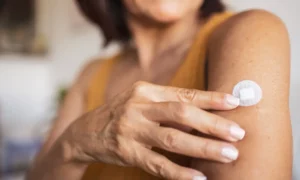Hot flashes, a common experience primarily associated with menopause, can occur in various stages of life and impact individuals differently. Understanding the symptoms is crucial for effective management and improved quality of life. In this article, we will talk about what actually are hot flashes, the causes causing them, the symptoms to look out for, and different approaches to managing them.
Contents
What Are Hot Flashes? 
When hot flashes occur, a sudden sensation of heat, accompanied by a red and flushed face as well as sweating, is experienced. The exact cause of hot flashes is not fully understood, but they may be linked to a decrease in estrogen levels and alterations in the part of the brain that regulates body temperature.
During a hot flash, blood vessels near the skin’s surface widen, aiding in the cooling process and leading to perspiration. Some women may also experience a swift heart rate or chills.
When these episodes happen during sleep, they are termed night sweats. Night sweats can disrupt sleep, causing awakenings and difficulties in obtaining sufficient rest.
The term “hot flush” refers to the redness observed in the face and neck during a hot flash.
What Are The Causes Of Hot Flashes?
Hot flashes are primarily caused by hormonal changes, especially a decrease in estrogen levels. The exact mechanisms triggering hot flashes are not fully understood, but they are commonly associated with:
- Menopause
The most common cause of hot flashes is the hormonal changes that occur during menopause. As women age, there is a natural decline in estrogen levels, which can lead to the onset of hot flashes.
The transitional phase leading up to menopause, known as perimenopause, involves fluctuations in hormone levels, including estrogen, contributing to the occurrence of hot flashes.
- Surgical Menopause
Women who undergo surgical removal of the ovaries (oophorectomy) experience an abrupt and significant drop in estrogen levels, which can trigger hot flashes.
- Breast Cancer Treatment
Certain breast cancer treatments, such as hormonal therapies and chemotherapy, can induce menopausal symptoms, including hot flashes.
- Hormonal Disorders
Conditions affecting the endocrine system, such as polycystic ovary syndrome (PCOS) or disorders of the adrenal glands, may disrupt hormonal balance and contribute to hot flashes.
- Medications
Some medications, including certain antidepressants, anti-anxiety drugs, and medications that lower estrogen levels, may be associated with hot flashes as a side effect.
- Thyroid Disorders
Disorders affecting the thyroid, such as hyperthyroidism, can influence the body’s temperature regulation and potentially contribute to hot flashes.
- Smoking
Smoking has been linked to an increased risk of early menopause, potentially leading to the earlier onset and increased severity of hot flashes.
- Weight and Body Composition
Women with a lower body mass index (BMI) or those who have undergone significant weight loss may be more susceptible to hot flashes.
- Stress and Anxiety
Emotional factors, such as stress and anxiety, can trigger or exacerbate hot flashes in some individuals.
While these factors are commonly associated with hot flashes, it’s essential to recognize that the exact cause can vary among individuals.
What Are The Symptoms Of Hot Flashes? 
The common yet major symptoms of hot flashes are as follows
- Sudden Heat Sensation
Hot flashes often begin with a sudden and intense feeling of heat, typically originating in the upper body, such as the face, neck, or chest. - Flushing
The heat sensation is accompanied by visible redness and warmth in the skin, known as flushing. This is particularly noticeable in the face and may extend to the neck and chest. - Sweating
A physiological response to the heat involves sweating. Individuals experiencing hot flashes may sweat to varying degrees, ranging from mild to profuse. - Rapid Heartbeat (Palpitations)
The body’s response to the heat may include an increase in heart rate, leading to palpitations or a feeling of a rapid heartbeat. - Chills
Following the heating episode, some individuals may experience chills as the body cools down, leading to a temporary sensation of cold. - Duration and Frequency
Hot flashes can vary in duration, lasting from a few seconds to several minutes. They can also occur multiple times throughout the day, impacting daily life and activities. - Night Sweats
When hot flashes occur during sleep, they are referred to as night sweats. Night sweats can cause awakenings, disrupt sleep patterns, and contribute to feelings of fatigue. - Trigger Factors
Hot flashes may be triggered or exacerbated by factors such as stress, spicy foods, alcohol, caffeine, and hot environments. - Impact on Sleep
Night sweats, in particular, can significantly interfere with sleep, leading to disturbances and difficulties in achieving restful sleep. - Quality of Life Impact
The overall impact on an individual’s quality of life is substantial. Beyond physical discomfort, they can affect mood, concentration, and daily activities, potentially contributing to a reduced sense of well-being.
It’s important to note that while hot flashes are a common experience, their intensity and frequency can vary widely among individuals.
How Long Do Hot Flashes Last?
The duration of hot flashes can vary widely among individuals. Some women may experience hot flashes for a relatively short period, while others may have them for an extended duration. Here are general patterns of how long hot flashes may last:
- During Menopause Transition
Hot flashes often begin during perimenopause, the transitional phase leading up to menopause. This phase can last several years, typically starting in a woman’s 40s, and hot flashes may occur intermittently during this time. - Menopause Onset
Menopause is considered to have occurred when a woman has gone 12 consecutive months without a menstrual period. Hot flashes may be most frequent and intense during the months leading up to menopause and the first few years after menopause. - Postmenopausal Period
While hot flashes tend to decrease in frequency and intensity over time, some women may continue to experience them for several years after menopause. In some cases, hot flashes may persist into the postmenopausal period. - Individual Variability
The duration and frequency of hot flashes vary widely among individuals. Some women may have occasional, mild hot flashes for only a few years, while others may experience more frequent and intense episodes over a more extended period.
Different Approaches For Managing Hot Flashes 
Managing hot flashes involves a combination of lifestyle changes, self-care strategies, and, in some cases, medical interventions. Here are different approaches to help manage hot flashes:
- Hormone Replacement Therapy (HRT)
- Involves supplementing estrogen or progesterone to alleviate severe hot flashes associated with menopause.
- Decisions should be made in consultation with a healthcare professional, considering benefits and risks.
- Non-Hormonal Medications
- Certain medications originally designed for depression (SSRIs, SNRIs) can help reduce hot flashes.
- Consultation with a healthcare provider is necessary to determine the most suitable medication.
- Lifestyle Modifications
- Dietary Changes: Avoiding triggers like spicy foods, caffeine, and alcohol can reduce the frequency and intensity of hot flashes.
- Cooling Strategies: Wearing light clothing, using fans, and keeping the room cool can alleviate discomfort.
- Regular Exercise: Engaging in activities like walking, swimming, or yoga may help reduce hot flashes.
- Mind-Body Techniques
- Relaxation Techniques: Deep breathing, meditation, and mindfulness can manage stress and reduce hot flashes.
- Yoga and Tai Chi: These exercises positively impact menopausal symptoms, including hot flashes.
- Acupuncture
- Involves the insertion of thin needles into specific points on the body.
- Some women find relief from hot flashes through acupuncture.
- Herbal Remedies
- Supplements like black cohosh and soy isoflavones have been explored for managing hot flashes.
- Consult with a healthcare provider before using herbal remedies.
- Behavioural Interventions
- Cognitive-behavioral therapy (CBT) helps cope with the psychological aspects of hot flashes.
- Improves overall well-being.
- Weight Management
- Maintaining a healthy weight through diet and exercise can reduce the severity and frequency of hot flashes.
Individual responses vary, so consult with a healthcare professional for personalized advice. Persistent or bothersome symptoms should be discussed with a healthcare provider for further evaluation and management.
Conclusion
In conclusion, understanding the symptoms of hot flashes is crucial for effective management. Whether you’re experiencing occasional flashes or dealing with persistent symptoms, seeking medical advice and exploring various coping mechanisms can significantly improve your quality of life.
If you are facing menopause related issues, menopause treatment at HerMantra can help. Book your free trial online menopause treatment session now.





